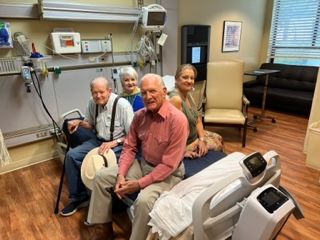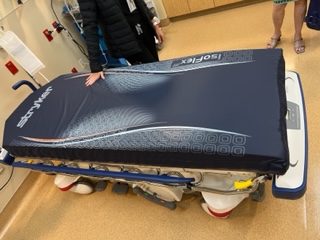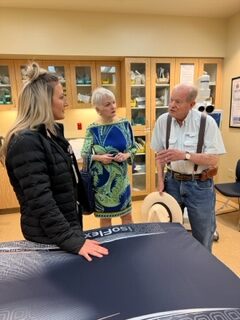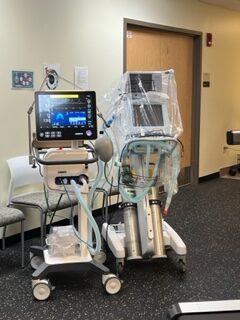Latest News
Welcome Dr. William Moore.
Interventional Spine Physician
Dr. William Moore is Board-Certified in Pain Medicine and practices Interventional Pain Management. His main focus is on treatment of the spine. In his practice, he utilizes a wide range of minimally invasive techniques to treat neck pain, back pain and chronic joint pain.
Born in Laredo, this Texas native earned his Bachelor of Arts in Business Administration from Trinity University in San Antonio. He went on to earn his medical degree at the University of Texas Health Science Center at San Antonio, followed by a residency in Anesthesiology at Ochsner Clinic Foundation Hospital in New Orleans. Dr. Moore then went on to complete his fellowship training in Pain Medicine and Interventional Pain Management at Texas Tech University Health Science Center in Lubbock.
Dr. Moore has always been intrigued by interventional pain management and its dynamic quality. “It’s an area of extreme innovation,” he says. “In the past, spine treatment involved non-invasive physical therapy or a large surgical intervention. There was not a place in the middle that could affect a patient’s quality of life. Now, new developments allow minimally invasive access to specific nerves, joints and discs with no incisions or very small incisions and a short recovery time. They provide a dramatic change in patients’ well-being.”
Dr. Moore and his wife have three children. He is an avid hunter and enjoys watching college football and Texas Ranger baseball.
To schedule an appointment with Dr. Moore, please call (254) 897-2202 or ask your PCP to fax a referral to (833) 803-0103.
Glen Rose Medical Center is continually looking for ways to improve our patient experience, recently GRMC applied for a grant available through The Hillcrest Foundation, a philanthropic organization created by Mrs. W.W. Caruth, Sr. (Mrs. Earle Clark Caruth) in 1958 to promote financial support for qualified Texas charitable organizations for the advancement of education, the promotion of health and the relief of poverty.
Mrs. W.W. Caruth, Sr. was from a pioneer family who settled in the Dallas area in 1848. The Hillcrest Foundation was created to carry the Caruth Family’s generosity to the people of Texas.
With the wonderful news that we had been awarded the grant, we went right to work, with careful consideration we chose to upgrade 8 of our Emergency Room patient beds and 5 of our Med/Surg (inpatient) beds. We chose the Stryker Big Wheel Beds for the ER as well as Stryker beds for our inpatient rooms. The addition of the new beds allows for safety alarm monitoring, accurate weight assist, the mattress can be inflated/deflated to assist with patient specific pressure points.
In addition to the new patient beds, we purchased a new ventilator. With the addition to our hospitalist program, we are able to care for a high level of acuity (sicker) patient. Our new ventilator is the newest technology, allowing for easier patient transport for scans, and overall better care for the patient.
We were honored to have members of the Caruth family tour the hospital, see the benefit of their generous contribution to the medical center, tour the radiology department and learn all about the new CT scanner and 3D mammography machine and meet the team at GRMC. We truly enjoyed and appreciated the visit.
The team at Glen Rose Medical Center has been diligently upgrading and adding new physicians and services to better serve our community, keeping patients closer to home with family and friends.
We would love to see you at our monthly Coffee Talk at Grounded Coffee Shop, the second Friday of each month at 9:00 a.m. We will talk about what’s new and coming to GRMC as well as meeting other people in the community. Stop by we’ll buy you a cup of coffee and talk. Come grow with us.




We are ready to launch!!!
We are happy to announce our Hospitalist Program that will launch this week. With a hospitalist on staff, we will be able to provide a higher level of care to patients that might have previously been transferred to the metroplex. The hospitalist will work with your primary care provider to ensure you have the same personal experience that makes being a patient at GRMC special.
Now to introduce the Hospitalists.
Dr. Julia Hutchinson
We are excited to welcome Dr. Julia Hutchinson back to Glen Rose Medical Center. Dr. Hutchinson was an Internal Medicine with our team from 2007-2016. Since then, she has been in San Angelo, Texas working as a hospitalist and caring for patients in an inpatient and ICU setting. She is excited about coming home and heading up our hospitalist program at Glen Rose Medical Center.
Dr. Hutchinson is a board-certified Internal Medicine physician. She received her degree from the University of Washington School of Medicine. Dr. Hutchinson is passionate about delivering exceptional and personal cae to all adult patients in the hospital setting, especially the elderly. She brings a wealth of experience in acute illness and chronic disease management.
Dr. Hutchinson and her husband enjoy spending time at home with their four-legged children and traveling.
Dr. Paul Borgfeld
Please Welcome, Dr. Paul Borgfeld to our team at Glen Rose Medical Center. Dr. Borgfeld is a Board-Certified Internal Medicine physician. Dr. Borgfeld brings more than 38 years of experience, joining our team as a hospitalist alongside Dr. Julia Hutchinson.
Dr. Borgfeld received his degree from the University of Texas Southwestern Medical School in Dallas. He is coming to us from San Angelo, Texas where he has been a hospitalist caring for patients in the Intensive Care Unit since 2008. Dr. Borgfeld is skilled in diagnosing and treating a wide variety of illnesses and disorders in adult and adolescent patients.
Dr. Borgfeld and his wife, Beth have two sons and three grandchildren. When he is not working, he enjoys spending time with family, photography, and traveling.
We are happy to announce Glen Rose Medical Center (GRMC) was awarded a grant under the Rural Hospitals, COVID -19 in Healthcare Relief Grant Program. Glen Rose Medical Center searches for revenue streams other than traditional payer sources and tax payer dollars to enhance care to our patients by bringing cutting edge technology. GRMC is expanding and growing to better serve our community’s healthcare needs.
Michael Honea, CEO of Glen Rose Medical Center realized an opportunity to improve our radiology department by delineating a portion of the grant funds to upgrade our current CT Scanner to a 64 Slice. A 64-Slice CT imaging scanner allows for the convenient and non – invasive diagnosis and screening of coronary disease (heart blockages). By utilizing a portion of the grant for the CT, we were able to allocate funds to upgrade our current 2D mammography machine to the most current technology 3D mammography machine. A 3D mammogram can detect up to 40 percent more cancers than a 2D mammography machine.
The remainder of the grant will focus on upgrading our inpatient nurse’s station to allow better work flow and visibility of the unit. This is the beginning phase of a “Step Down” care area that will allow a higher level of care for our patients. A “Step Down” unit is between an ICU and typical inpatient hospital stay.
Another exciting addition includes developing and employing a hospitalist program, this will allow for continuity of care during a hospital stay. The Hospitalist at GRMC will assist our physicians in caring for our patients allowing a more acute care patient stay in Glen Rose closer to family and friends. A Hospitalist can also admit patients from the Emergency Room, patients that typically have to be transferred to a healthcare facility in the Metroplex will be able to stay at GRMC.
We are thrilled to offer the new services to our community. We are a growing community and hope to add more services and upgrades in the future.
Please join us Thursday October 27th 4:00 p.m. – 6:00 p.m. in the lobby of Glen Rose Medical Center, to meet our team.
We would like to invite you to the team at GRMC. Come take a tour, test drive the DaVinci Surgical Robot, talk to our department team leaders and find out about all the services available at GRMC. We will have goodies, food and lots of friendly smiling faces to answer all questions related to Glen Rose Medical Center and our Physician Clinic Group.
We look forward to seeing you seeing you on October 27th.

PRESS RELEASE: COVID-19 UPDATE
January 26, 2022
Good evening!
My apologies for not giving an update sooner. Thing have been quite busy over the last 3 weeks due to the surge of COVID-19 caused by the Omicron variant. According to CDC and Texas data, almost 100% of current COVID cases are being caused by the Omicron variant. The data shows that patients infected with this virus are, in general, less sick than with Delta, or other variants. Obviously, it is still making some patients very sick, as hospitalizations continue to be elevated across all of Texas at this time.
As of 01/25/2022, Somervell County has experienced 1925 total known cases of COVID-19 since the beginning of the pandemic. Somervell County has recorded a total of 31 deaths attributable to COVID-19 infections and our current active case report is around 170-190 patients. The case fatality rate in Somervell County is 1.61%. Statewide case fatality is 1.38%. Both of these numbers have started to drop due to the high volume of new cases, and relatively low number of fatalities due to Omicron. Despite this, January 2022 is tied with August 2021 for the most fatalities in a single month for our county (5). The majority of deaths in Texas are above age 50.
Most of the illnesses, hospitalizations, and deaths in the state and locally, are occurring in unvaccinated individuals. The data shows that 80% of hospitalizations, 90% of ICU/ventilator patients, and 98%+ of fatalities are occurring in unvaccinated patients. Due to the increase contagiousness of the Omicron variant, more vaccinated individuals are experiencing breakthrough cases. In general though, these patients are not getting very ill, although there is an exception to every rule. Data confirms that the length of time since being vaccinated is likely to increase the risk of infection. This is the rationale for booster shot recommendations, and, it appears that higher antibody levels are correlated strongly with less breakthrough infections. New research has shown that a booster protects patients from Omicron for at least 4 months after the booster.
Booster shots are widely available. Anyone age 12 and up, is eligible for a booster shot 5 months after receiving their second shot of either the Pfizer or Moderna vaccines, or their first shot of the Johnson and Johnson vaccine. Data is showing that changing vaccines can improve immunity, especially for patients who started out taking the J&J vaccine.
The most current numbers are found at: https://dshs.texas.gov/coronavirus then click on the button that says TEXAS CASE COUNTS. This website will be the most consistent place to get information regarding local and statewide numbers. Please note that the state is no longer providing a count of “active” cases. The number above, is a calculation that I am performing locally.
Hospitalizations are stabilizing statewide. ICU beds continue to be filled at a higher rate than hospital beds in general. About 1 out of every 4 COVID patients in the hospital is in a ICU bed. Over 2,700 hospital ICU beds are currently caring for patient ill with COVID-19. There is a total of 13,291 COVID-19 patients currently admitted to Texas hospitals. 1,551 Texans are currently on ventilators due to the severity of their COVID-19 infection.
Patients continue to have a much higher risk of complications and/or death from the disease, compared to the risk of complications from the vaccines. If you would like to get vaccinated, please start by calling your doctor’s office, or your pharmacy. Vaccines are readily available at this time for anyone aged 5 and up.
Monoclonal antibody treatments are no longer available locally. For very high risk patients, sotrovimab is available in the metroplex, and your doctor should be able to help get you on the list if you qualify. Other treatments, such as Paxlovid, remdesivir, and molnupiravir are also hard to find. They should be reserved for our highest risk patients, especially those high risk patients who are not vaccinated.
If you choose to not be vaccinated, and have not had the disease, avoiding crowds/social distancing, especially indoors, good hand hygiene, and masking up are still the best ways to avoid getting any version of the virus causing COVID-19.
Data continues to suggest that immunity from surviving the disease is more effective than vaccination in the short term. Unfortunately, there is no effective way of proving how long that immunity will last. Many patients have no detectable antibodies as soon as 4-5 months after infection. At a year out from infection, as few as 15% of patients have detectable antibody levels. Disease survivors can still get vaccinated, and in fact, it is recommended. Patients who have had the disease, and subsequently get vaccinated, have the strongest immunity, according to the most current data that I have seen.
Some things haven’t changed….to help protect our community, if you are ill, please do not go to work/school/out to shop. Parents, please do not send your children to school when they are sick.
Masks are not perfect, but if you are ill and must go out, wearing a mask will help decrease the chance that you could infect someone else in you community or household. N-95 or KN95 masks are preferred, with disposable surgical masks next in line. Cloth masks/gaiters are the least effective, but still are better than nothing.
The good news, is that the Omicron variant may have peaked already, both in Somervell County and in Texas. Compared to this time last week, active cases seem to have dropped by about 22.5% in our county. I hope that this trend will continue.
Stay safe, and thank you for taking the time to read this!
Steven J Vacek, M.D.
Glen Rose HealthCare Inc.
Somervell County Local Health Authority
In light of the increasing number of COVID-19 cases, please keep in mind that our emergency rooms (ERs) and urgent care centers are for those needing higher levels of care. Thank you for your understanding and for helping us ensure our facilities are ready for those who need care most during this time.
If you are experiencing mild to moderate symptoms, please contact your primary care physician for available testing in a clinical setting.
If a member of your household, friend or loved one has tested positive for Covid and you have had direct contact with them and are experiencing Covid-like symptoms assume you are also positive for Covid. Please follow CDC guidelines for quarantine. Please seek medical attention if you become seriously ill, have difficulty breathing or condition has worsened.
We urge the community to help us and each other by getting vaccinated, getting boosted, distancing and wearing a mask.
© 2024 by Glen Rose Medical Center. All Rights Reserved. | Price Transparency
